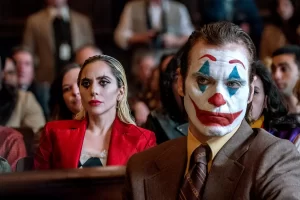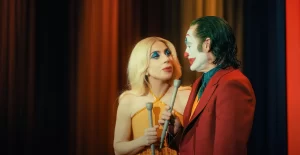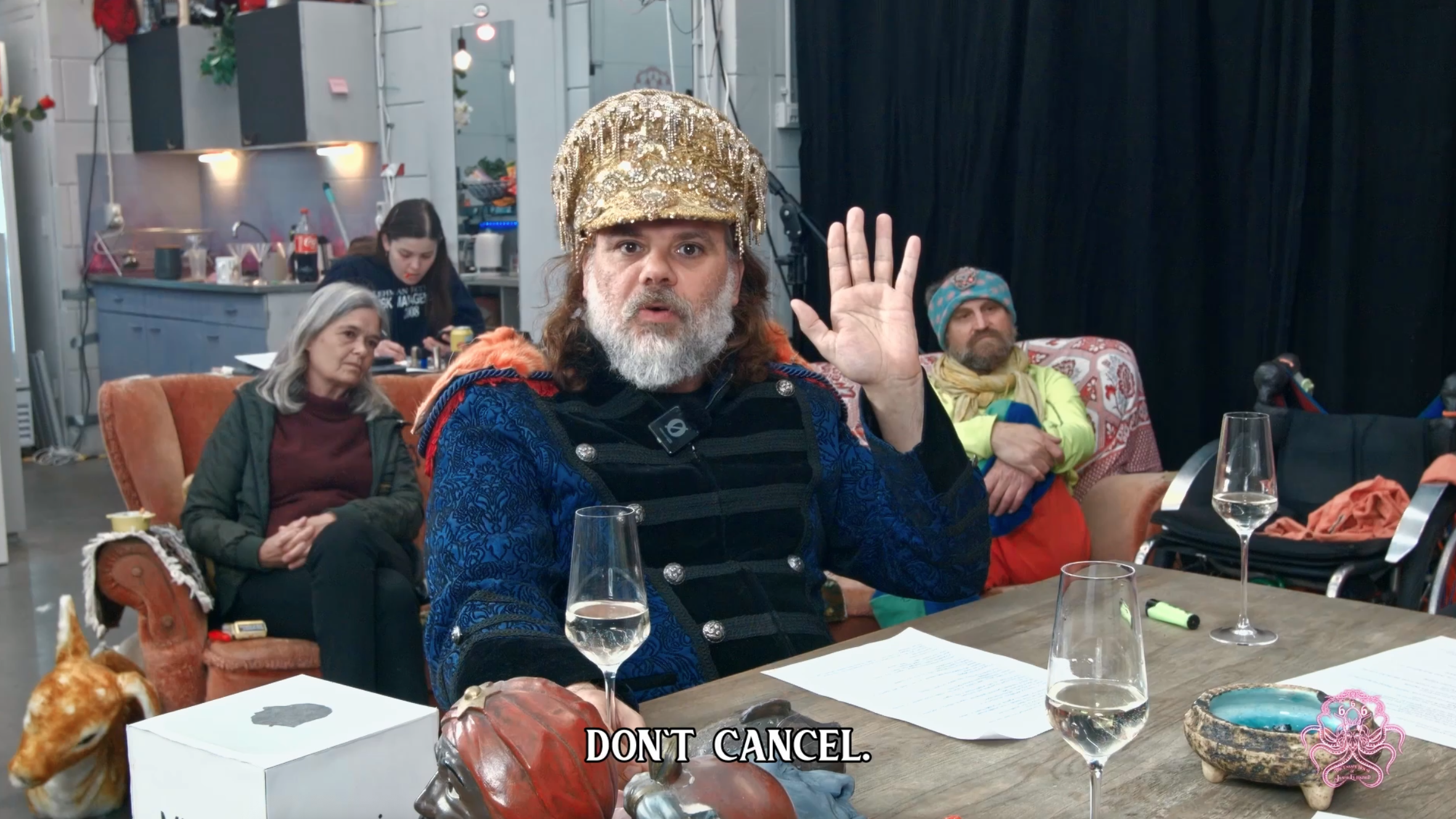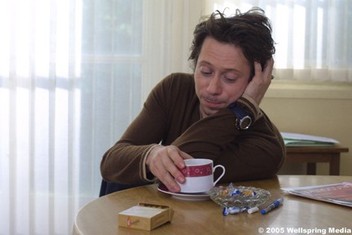By Carlos Dengler
Watching a movie in an empty theater reminds you that film remains (at least putatively) an art form. Like visiting a church in between services, sitting amid vacant seats munching popcorn can be a kind of private encounter with the sacred: the ritual and its underlying beliefs, now unmediated by social context, come into sharp focus. Under these more ruminative conditions, a movie’s merits and flaws resist the usual sort of excuse- or hype-manufacturing that often accompany a night out with friends. You can let the movie come to you on its own terms.
Such were the conditions under which I chose to catch one of the last showings of Joker: Folie á Deux, Todd Phillips’s follow-up to his wildly successful Joker. With the original grossing the highest revenue in history for an rated ‘R movie’, along with an Oscar win for its lead actor, it was always going to be the case that, no matter what the director had created, the sequel would be greeting audiences freighted with more baggage than a royal caravan. Few films in 2024 came to theaters under the penumbra of scrutiny with which this second installment in the franchise had arrived and, as it turned out, the visceral hatred that followed in its wake can now be seen as underscoring what little chance it ever really stood to win anyone’s heart in the first place.

I nonetheless found the register of all of the vituperation rather curious. It is one thing for a movie to cause widespread disappointment; quite another to inspire the type of hysteria and outrage, from critic to podcaster to fanboy, that followed this release. Which is perhaps why I waited several weeks’ time before seeing it, after the negative hush around this supposed train wreck of a movie had died down. The critical distance afforded me by the gap in time, along with being one of only two audience members on the early evening I caught the film, would help me unpack this scorned movie’s contents and disentangle what actually belonged it from what belonged to the audiences and their expectations. The theater was dark, not a mouse was stirring and the popcorn was fresh.
I came in psychologically prepared, like I was visiting a friend who’d survived a fire, hoping the damage wouldn’t be too bad, but prepared for something gruesome all the same. After all, given the reaction, this film had to be as bad as everyone was saying it was, didn’t it? I thought that, seeing it with my own eyes, the hatred would finally make sense. And, in a way, it did: it was obvious that the average DC comics fan—along with the average moviegoer—was always going to be deeply upset by this bucking of expectation, something that Phillips had assuredly integrated into his understanding of how the film would be received while he was making it.
What really surprised me, however, was that the movie itself, as a piece of filmmaking, appeared so undeserving of the rancor hurled at it over the past several weeks. I was expecting a film with lazy storytelling, bad acting, gratuitous scenes, misguided execution or any other number of filmmaking ingredients which directors often don’t take seriously when it comes to generating franchise fodder in the form of sequels. I thought Joker: Folie á Deux would join the ranks of all the train wreck sequels we have come to more or less expect as a matter of course from our beloved blockbuster hits.
Yet, what I saw was far from a train wreck but a rather competently directed—albeit bizarre—psychological thriller which, like its predecessor, worked off of a standard, coherent screenplay with the sort of usual three act structure we generally come to expect from genre fare at the box office. The deep character focus and monochromatic post-production that was evident in the film are staples of the Soderbergh/Fincher school. Additionally, the score did its job, the color set the mood, and the supporting cast memorably portrayed their characters. Given these well-executed elements, I was at a loss to see what was so bad about the movie.
The acting was perhaps what I found the most confusing in the light of the blowback this movie received. This was probably Lady Gaga’s best performance so far and it goes without saying that Joaquin Phoenix’s performance (he is one of our generation’s greatest actors) was iconic. I am haunted by his tortured petition to Gaga’s Harley Quinn towards the end of the film, by those very iconic steps he made famous in the first movie, as he begs her not to abandon him. The layers of anguish, love, disappointment, illness and passion that Phoenix is able to communicate, just with one line of text (“I can’t go on without you”), are beyond astonishing.
There was, of course, the lofty concept, with the musical numbers perhaps delivering the proverbial salt on the fans’ wounds of disappointment, the upsetting fact that Phillips would not be giving them what they wanted. (Interestingly, it is possible to read the baffling choice to turn the sequel into a musical as a subtle commentary on the inherent hokeyness of comic books. This perhaps Brechtian observation was given to me by the other audience member of the showing I attended, as we shared our own puzzlement over the film’s by that point infamous blowback on our way out of the theater).

Whether or not fan anger was a deliberate strategy in making this film we shall likely never know (I lean a little towards yes); but that expectations were to be defied was nonetheless obvious from the beginning—what with an opening animation sequence. With its deliberative pace, absence of action or violence, abundance of close-ups and theatrical constraints to basically two interiors—it is set entirely in a prison and a courtroom—, this sequel was clearly intended not as a sequentialized entry but as a postmodern framing device for a whole slew of fancy ideas.
Even so, these admittedly highbrow literary devices were nonetheless fitted neatly into what seemed by the end of the film to be a simple, basic, slow-moving story about a famous murderer colliding with his own mythos. And so whether or not Folie á Deux is a particularly great movie is really beside the point. One can’t help but to see a glaring disconnect between what amounts to at worst a mediocre movie and a seething, reactionary odium coming on the heels of its release.
I suspect that the negative reviews are not about what this movie is, but what it is not. But what it is not goes further than mere defiance of expectation: Folie á Deux’s sin is precisely that it dares to make an attempt at art and in this ambition it presents the public with an image of disobedience, the kind which, in its implicit critique of the status quo, often drives people—those whose sense of order is wedded to doses of comfort from that status quo—to hysterics. Phillips has accomplished something of a Hollywood no-no here, a verboten enunciation of the conspicuously hidden diktat of superhero franchises which stipulates the application of literalism onto the stories within their respective universes. If this sequel is guilty of anything it is this “sin” inlaid in the proscriptive morality of an entire pop culture consumption apparatus.
The villain-turned-antihero at the center of the focus is here transformed from his literal embodiment in the original into a signifier for an array of problematics and it is in this sense that Folie á Deux must be understood as a polemical exercise. The Joker’s courtroom trial, the preponderant mise en scene of the film, is a miniaturized cosmos in which big pieces are chewed, where the great problems of the entertainment-industrial complex—persona, fame, spectacle, aura, worship, mass politics, commodity production, mechanical reproduction—are played out. Given these conceptual preoccupations, it is not surprising one bit that Folie á Deux ends up as a deeply compassionate portal into the pain of the villain at the center of the drama, a human being who, much as in the original, is rendered as a tragic casualty of the social decay inherent within the capitalist project. The inheritance from Brecht’s own Threepenny Opera, specifically “How to Survive” (“Our middle’s empty, that’s where it all begins), is obvious. And just as in Brecht, the irony established between a work’s visible conceptual architecture and its pulsating humanity within is a prevalent modality in Folie á Deux, a technique which Phillips had innovated in the original Joker and has now taken in the sequel to its logical extreme.

The appropriation of a well-known superhero villain, as opposed to, say, one the director made up out of whole cloth, is one of the necessary fixtures of the movie’s polemics. Our visceral possessiveness around pop cultural intellectual property, the “commodity lust” cultivated by the entertainment-industrial complex, is noted in the film, through the relentless protagonist POV, as a conspicuous anthropological phenomenon, one that deserves much more attention than it usually gets at scale.
As such, Phillips’s foray into this exploration should be applauded merely for trying. And yet, in the many irate condemnations, such as a memorable one on the Piers Morgan show from a YouTuber flailing at Hollywood’s supposed contempt for fans, it is this point which is being continually reiterated, that the dynamics of production in late capitalism have cultivated a proprietary lechery (“toxic fandom”) towards pop culture figurations, one which producers tamper with on pain of consumer blowback. That Folie á Deux is unequivocal in its contempt for the dehumanizing “bread and circuses” of the industry foisted around the personage at its center of focus serves as the negative corollary to the humanism of its portrayal of Joker the man, Arthur Fleck, the putative true ego, agitating for centrality throughout the film.
This is another way of saying that, if Phillip’s appropriation of the Joker in the service of his polemical exploration communicates audience contempt, well, in a certain respect, given the reactivity among critics and fans to an at worst mediocre film, the contempt seems to appear justified. The film’s vaulting ambition, if perhaps quixotic, is nonetheless transparent: it is curious to make so much of this film’s excesses when its intentions were so clearly well-intentioned. The methodological discipline of the movie in its examination of mental illness, trauma, social decay, loss, fame, spectacle, persona and self should present no ambiguity as to the promises already set by the first frame. This does not say anything about success, though the reaction does seem to say much about permission.
The resentment engendered by this film’s dismissal of franchise responsibility finds a neat diegetical parallel as Arthur Fleck wrestles with the mythos that has arisen around the Joker phenomenon, ultimately choosing to risk backlash in order to definitively assert his authentic subjectivity. Arthur Fleck is not the Joker, this movie seems insistent on getting across and, for good measure, he is killed off at the end to seal the deal. The double sided coin of fan adoration, which includes hatred as its necessary corollary, is thereby illustrated vividly in this movie. There seems to be a design clearly intended here to closely parallel within the film’s portrayal of the virulent reactivity Fleck experiences with the same virulent reactivity the film caused in real life.
Almost all of the ligature of social critique in this film can be gleaned just from this last scene, when a prison psychopath intercepts Fleck in a hallway and takes his life with a blade. Phillips was careful with the casting of Arthur’s murderer, an actor with a very strong resemblance to the late Heath Ledger (who gave us one of the finest portrayals of the Joker almost two decades ago). Here Phillips seems to be retconning Christopher Nolan’s Joker as an anonymous rogue agent whose story is now, through this act, cordoned off from the humanistic origin story it appeared he had wanted to establish with his two Joker films.
Two readings, somewhat contradictory towards each other, are available from this narrative decision. In one, there is a respect given towards the Joker’s incommensurability as the personification of evil. Here the parallel with Gordon’s pithy explanation of what motivates the Joker from The Dark Knight (“Some people just want to watch the world burn”) with Iago’s similarly pithy final explanation for his motivations in Othello (“Demand me nothing. What you know, you know./From this time forth I never will speak word”) is reinforced. Evil has no origin story, for to grant it such is to humanize what can not be humanized. The metaphysics of evil as an indissoluble element of psyche, a formulation of the human experience to which most comic book villains adhere, is preserved. Fleck’s assassination in the bowels of a prison can be seen, then, as an act of restoration. Comic book orthodoxy, one of Phillips’s chief targets when he set out to cast this villain as “human, all too human,” is seemingly reinstated as the norm.

However, I find this slightly pat and unsatisfying as the mere explanation for the rug pull to which he treated audiences with this unanticipated artistic decision, one which appeared to many as a flouting of narrative responsibility. What is the point, one should ask, if Arthur Fleck was never the Joker in the first place, of embarking on this escapade over the past half decade?
The answer, which comprises the second, more satisfying, reading of this scene, can be gleaned from the cinematography. The critical act which connects Arthur’s assassin with the Nolan Joker is the self-harm he accomplishes with his knife, as he cuts a permanent “smile” on his face as Fleck lies dying in a pool of blood, a clear referent of the infamous “why so serious” line of Ledger’s Joker. This act is rendered in soft focus, with the actor crouched in the background while Fleck, in severe, crystal clear close-up, stares intently into the camera, his pleading eyes exhorting us in his final moments. Obviously, the relationship between background and foreground is critical in this closing shot: the Joker, that mythic creature which has been over and again revamped, revitalized and reconsidered (some would say, ad nauseam), is a distant figure, his movements almost indiscernible, while Arthur Fleck, the man who was seemingly to become the Joker, breathes his last breath right in front of us.
That Phillips perhaps equivocates here as to who the real Joker is can be read as a sign of caginess, or it can be read as a challenge to audiences, who are now charged with answering the question. But there is a glaring constraint on our own abilities. For those of us who insist that the real Joker was the villain so frequently portrayed over close to a century of comic books lore, that declaration must now reckon with a very human version of that mythology, one which captivated us for some years in the stunning portrayal of Joaquin Phoenix. In the second film, it is this Arthur Fleck who stares right back at us as he bleeds to death on the floor of a hallway in a prison. We are now to decide. Far from a rug pull, is a test. And, if the film’s reaction is anything to go by, it is a test I am not exactly confident many of us are in any position to take seriously.
I predict that, along with another “dud” from 2024, Megalopolis, Joker: Folie á Deux will go down in cinema history as a grossly misunderstood movie. Sometimes an artistic statement occurs with very poor timing and I believe this explains most of the harshness of both films’ receptions. The expectations which come loaded into the social exercise of moviegoing often do not enable more critical appraisals and some films simply are intended to be seen according to a different type of consensus than a social one.
Yet, even if Folie á Deux never receives its deserved reexamination and is kept in its present location on the pop cultural trash heap, it will nonetheless point to a rather inconvenient truth: that fan culture, along with the imperious drug dealer fueling its habit, the entertainment-industrial complex, is a conservative, reactionary force that more often than not refuses to countenance the possibility that experimentation and self-examination are two essential components of the artistic experience, which itself constitutes our humanity. The dehumanization of fan culture is an important theme which too infrequently receives attention and this Joker movie will go down as an exemplary treatment of this phenomenon. At its root, the problem of fan culture points to the much larger problem of social atomization and commodification within late-capitalism. This movie should instill a constructive sadness in depicting so genuinely fan culture’s seeming exuberance in joining the industry to take up arms against artistry.
The disappointment which followed this film’s release is actually a hasty sublimation of contempt for a perceived sin, that a film director chose to attempt to make a work of art instead of genuflecting to industry imperative. Arthur Fleck himself was trying to say this to us, all the way to his necessary end. I hope more of us will become receptive to his plea.
Carlos Dengler is an NYC-based composer, actor, writer, multi-instrumentalist, naturalist, avid backpacker and amateur nature photographer. My interest initially stemmed from his time in the music group Interpol and continues to this day, for obvious reasons.
Read an interview with Mr Dengler and myself (R.JACKSON)
Read more of Carlos Dengler’s thoughts on his own channels – https://www.carlosdengler.com/



